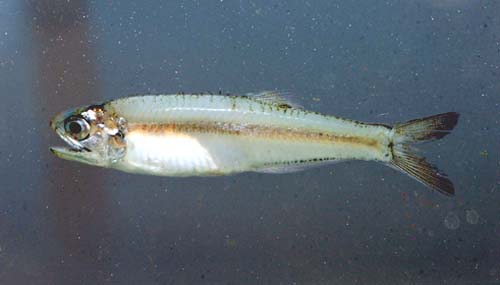| Engraulidae (Anchovies), subfamily: Engraulinae |
| 10 cm SL (male/unsexed) |
|
pelagic-neritic; freshwater; brackish; marine; depth range 1 - 70 m, amphidromous |
| Western Atlantic: Casco Bay, Maine south to Florida Keys and westward around the Gulf of Mexico south to Yucatán; not in the West Indies. |
|
Dorsal spines (total): 0-0; Dorsal soft rays (total): 0-0; Anal spines: 0-0; Anal soft rays: 23-31. Body variable, more slender in northern populations. Snout fairly blunt, a little over 1/2 eye diameter; maxilla long, tip pointed, reaching beyond hind border of pre-operculum, almost to gill opening; panamensis-type gill cover canals. Anal fin rays rarely 28, its origin below unbranched dorsal fin rays. Anus nearer to pelvic fin tips than to anal fin origin. |
| More commonly found in shallow tidal areas with muddy bottoms and brackish waters, tolerating a wide range of salinities (virtually fresh to fully saline or hypersaline). Found only in spring and summer in the tidal portion of the Ochlockonee River, Florida. Feed mostly on Mysis and copepods, also small fishes, gastropods and isopods. Breed off North Carolina from late April to mid-July, perhaps through to August. Used to some extent to make anchovy paste (Ref. 189). |
|
Least Concern (LC); Date assessed: 20 October 2011 Ref. (130435)
|
| harmless |
Source and more info: www.fishbase.org. For personal, classroom, and other internal use only. Not for publication.

